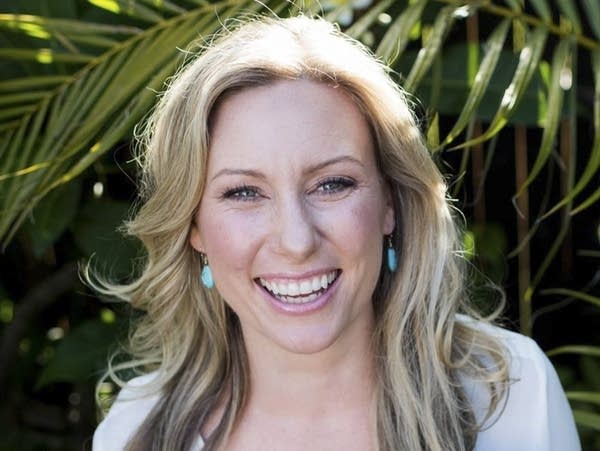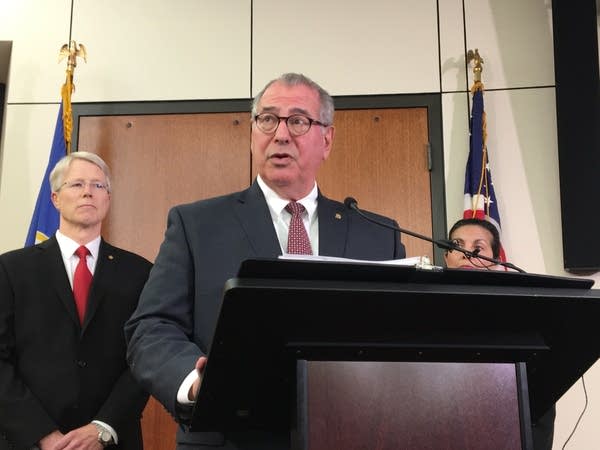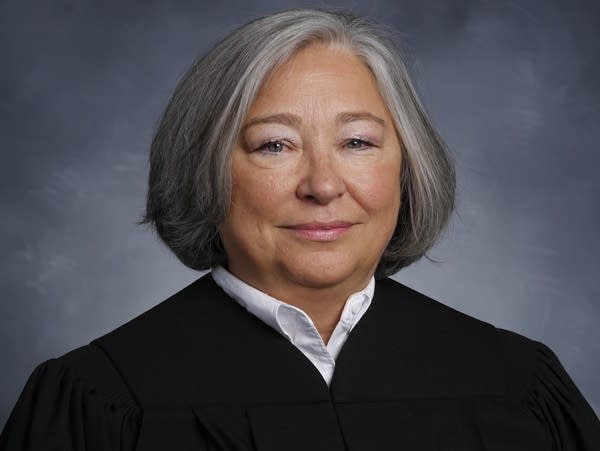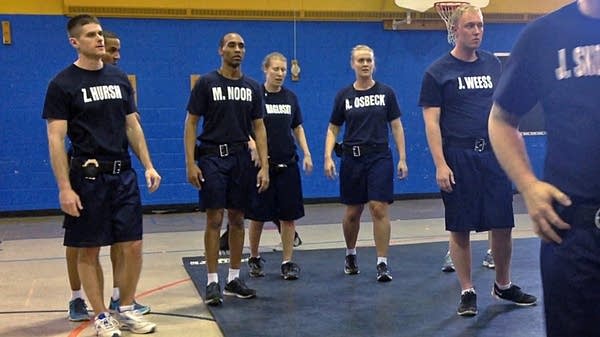The trial of ex-cop Mohamed Noor: What you need to know

Go Deeper.
Create an account or log in to save stories.
Like this?
Thanks for liking this story! We have added it to a list of your favorite stories.
A former Minneapolis police officer faces trial Monday in the killing a 40-year-old woman who had called 911 for help.
The shooting death of Australia native Justine Ruszczyk by former officer Mohamed Noor sparked protests and calls to reform policing in the Twin Cities and produced shock and disbelief across the Pacific Ocean.

Ruszczyk called 911 on July 15, 2017, to report what she thought was a woman being assaulted outside her home. Noor was a passenger in the squad car that responded to the call. Noor shot and killed Ruszczyk through the open driver's side window after she approached the squad car from behind.
Noor is facing three felonies in Ruszczyk's killing; second- and third-degree murder, as well as second-degree manslaughter.
Turn Up Your Support
MPR News helps you turn down the noise and build shared understanding. Turn up your support for this public resource and keep trusted journalism accessible to all.
Convictions of police officers in deaths they caused while on duty are rare in the United States. But defense attorneys have already suggested that Noor, who is Somali-American, may contend with bias from jurors.
How rare is a conviction?
Officers are rarely convicted even when the case against them is strong because the law authorizes them to use force, said David Harris, a professor at the University of Pittsburgh School of Law.
"Police officers, of course, have a self-defense right, but they also have the right, and sometimes even the duty, to use force in the course of their jobs," Harris said.
The Supreme Court has ruled that jurors can not judge a case like Noor's based on 20/20 hindsight. Instead, jurors are asked to consider whether an objective, reasonable officer would see the force as justified.
All these factors, and many jurors' natural instinct to favor police, can make it difficult to convict officers in on-duty killings, Harris said.
There are about 1,000 on-duty killings by police officers in the United States each year, according to the Washington Post. Since 2005, a total of 35 officers in the United States have been convicted of on-duty killings, said Bowling Green State University criminal justice professor Philip Stinson.

Noor is the second police officer to go on trial for an on-duty killing in Minnesota. Former St. Anthony police officer Jeronimo Yanez was found not guilty of manslaughter a month before Ruszczyk was killed in the shooting death of Philando Castile during a traffic stop.
What do prosecutors need to prove?
Noor is facing three charges in Ruszczyk's death.

• Second-degree murder is the most serious charge. It requires that prosecutors prove beyond a reasonable doubt that Noor intended to kill Ruszczyk. University of Minnesota Law School professor JaneAnne Murray said if Noor is convicted of intentional murder, the jury won't even consider the other two charges against him.
• Third-degree murder requires a "depraved indifference," Murray said. "The classic example is shooting from the top of a hill onto a moving train — utterly reckless as to who might be hurt in the process."
• Second-degree manslaughter requires what's called "culpable negligence," where the defendant creates an unreasonable risk that they knew could kill or seriously injure someone.
Noor has pleaded not guilty to all charges.
Will Noor testify?
It's also unclear whether Noor will take the stand at his trial. He chose not to interview with investigators, and it's his constitutional right not to testify. Murray said testifying can help convince jurors of his defense.

"Assuming he's able to testify in a compelling way and give a compelling narrative, he can evoke sympathy," Murray said. "He can also convince the jury that the actions and deeds were justified in those moments leading up to her death."
Testifying can also have drawbacks. It opens the defendant up to cross-examination. Hennepin County District Judge Kathryn Quaintance has said she may consider allowing additional evidence, like a psychological exam Noor was given by Minneapolis police, if Noor takes the stand.
How will racial dynamics affect the verdict?
Criminal charges are something police-accountability activists have pushed for in other cases involving officers. The stark difference between the Noor case and many other high-profile shootings by police is that Noor is black and the victim, Ruszczyk, is white.
Noor's attorneys have already argued in court that Noor's ethnicity and religion — he is Somali-American and Muslim — will make it difficult for him to get an impartial jury.
Minneapolis City Council member Abdi Warsame said some right-wing media falsely implied Noor shot Ruszczyk for religious or cultural reasons.
"Him being Somali, I could understand the impact it would have on the community," Warsame said, "but he was a police officer first and foremost, and he should have been treated like any other police officer."
If Noor is convicted, Harris said it could actually undermine some efforts at increasing police accountability.
"For many in communities of color, they're so used to seeing the racial patterns of criminal enforcement by police or sentencing by courts," Harris said. "This will seem like not just a singular example of something happening, but another in a long train of examples where a person gets a different kind of justice because of what they look like."
What happened on July 15, 2017?
It was a warm July evening in the sleepy southwest corner of Minneapolis. Ruszczyk was in her pajamas when she thought she heard the sound of a woman being assaulted, according to the charging document.
She called 911.
Ruszczyk told the operator she could hear someone in the alley behind her house. She wasn't sure if the woman was having sex or being assaulted, but Ruszczyk thought she heard her yell for "help."

She waited, then called 911 again to make sure the officers had the correct address.
While she waited inside her house, Ruszczyk dialed her fiance, Don Damond, who was on a business trip. She saw the officers arrive at the end of the alley in an SUV. Her last words to Damond were "OK, the police are here."
Investigators say Noor's partner, Matthew Harrity, was driving with his window down. Noor was in the passenger seat. The squad's headlights were off, and Harrity shined a spotlight as the squad rolled slowly through the alley.
Harrity later told investigators that the two officers heard a dog but didn't see anyone in the alley. Neither officer got out of the squad. Noor entered "code 4" into the squad's computer, signalling that the officers didn't need any help. Harrity turned the headlights on and prepared to leave for another call.
As the officers waited for a bicyclist to cross in front of the alley, Harrity said he heard a voice and a thump on the squad car that "spooked" him. Harrity saw someone's head and shoulders, but couldn't tell whether it was a man, woman or child. Harrity told investigators he took his gun from his holster but kept it pointed down.
Harrity saw a flash and heard a loud noise. He looked over to see Noor's arm extended toward the open driver's side window. Ruszczyk was outside the driver's side window of the vehicle, holding her hands to a gunshot wound on the left side of her abdomen. She said, "I'm dying," or "I'm dead."

The officers got out of the vehicle. Noor was still carrying his gun. Harrity told Noor to put the weapon away. Neither of the officers had turned on their department-issued body cameras quickly enough to capture the shooting. About 14 seconds after the shooting, the officer's body cameras show them standing over Ruszczyk.
The officers took turns performing CPR on Ruszczyk. Firefighters and paramedics arrived. But Ruszczyk was declared dead at the scene.
Harrity is the only witness to the shooting. And the details he provided to investigators will be front and center in Noor's criminal trial.
Who was Justine Ruszczyk?
Ruszczyk had moved to Minneapolis from Australia to be with her fiance Don Damond. She was a yoga teacher with an Australian accent that neighbors say made it even easier to connect with her.
She also was known as Justine Damond.
In a recording posted to YouTube, she said depression, addiction and illness that she witnessed in her family had driven her to become a meditation coach.
"I was driven by fear, but I also had this deep innate sense that there had to be a better way," Ruszczyk said in the video.
Mindy Barry lived across the street from Justine Ruszczyk. She remembers the way Ruszczyk reached out to others in the community.
"She just was an easy, warm person," Barry said.
After she died, a video of Ruszczyk saving baby ducks from a sewer drain went viral.
Neighbors said it was her concern for others that led Ruszczyk to call 911 when she believed someone was in danger in the alley behind her home.
Who is Mohamed Noor?

Noor, now 33, became the first Somali-American officer at the Minneapolis Police Department's 5th Precinct in 2016.
He graduated with economics and business degrees from Augsburg University in 2011. Before enrolling in the Minneapolis Police Department's cadet program in 2015, Noor worked at a cellphone store and motels, according to personnel records. He trained at the police academy and graduated after 30 weeks.
Noor was discharged by the Minneapolis Police Department in March 2018 after prosecutors charged him with murder and manslaughter in Ruszczyk's death. He paid $90 to renew his Minnesota state policing license three days later.
Noor has expressed condolences to Ruszczyk's family through his attorneys but has not spoken publicly or been interviewed by investigators about the shooting.


